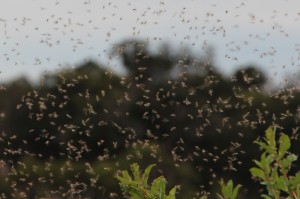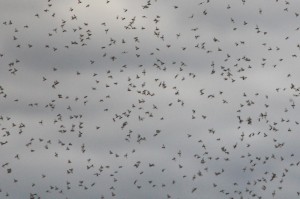Flying Ants
 One day after the rain, everywhere we went on the property, there were swarms of flying ants in their “Nuptial Flight“.
One day after the rain, everywhere we went on the property, there were swarms of flying ants in their “Nuptial Flight“.
According to Wikipedia, during the Nuptial Flight, virgin queens mate with males and then land to start a new colony. Young queens and males stay in their parent colony until conditions are right. Different colonies of the same species use environmental cues to synchronize the release of males and queens so that they can mate with individuals from other nests and avoid inbreeding. The actual “take off” from the parent colony is synchronized so that predators cannot eat the ants and virgin queens and males scatter to ensure outcrossing, the queens then release pheromones to attract males.
to ensure outcrossing, the queens then release pheromones to attract males.
One queen will usually mate with several males and the sperm is stored in the queen’s abdomen and will last throughout her lifetime. This can be as long as 20 years, during which time the sperm can be used to fertilize tens of millions of eggs.
According to an American website, they display a behaviour called “hilltopping” where they collect around tall or prominent features in the landscape, which is probably why we kept walking through clouds of them, they were using us as hilltops!
“Hilltopping” refers to their aggregation around prominent points of a landscape where they search for mates. A large tree, the chimney of a roof or even a tractor moving across the plains might serve as such an “action site” for swarming winged ants. Periodically, usually following heavy rain, the winged reproductive forms emerge from the colony in large swarms. Such swarming behavior is usually synchronized by other nearby colonies so large numbers of winged ants suddenly appear. All mating for the species takes place, often over the course of a single day. The males die and the mated females disperse to attempt establishing a new colony.
I zoomed in to enlarge the image to make sure they were ants and not termite swarmers and was relieved to notice their nipped in waists and uneven wing sizes.

Facebook